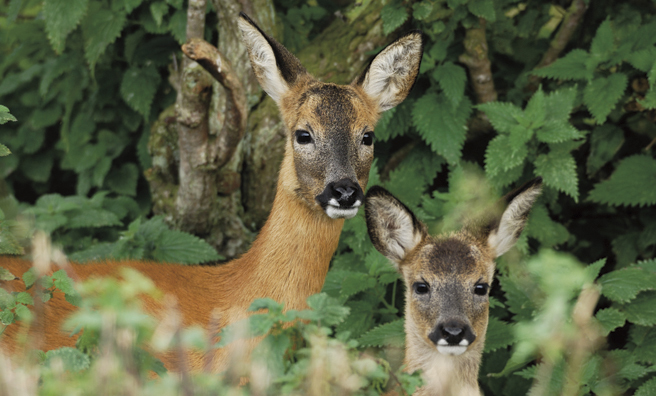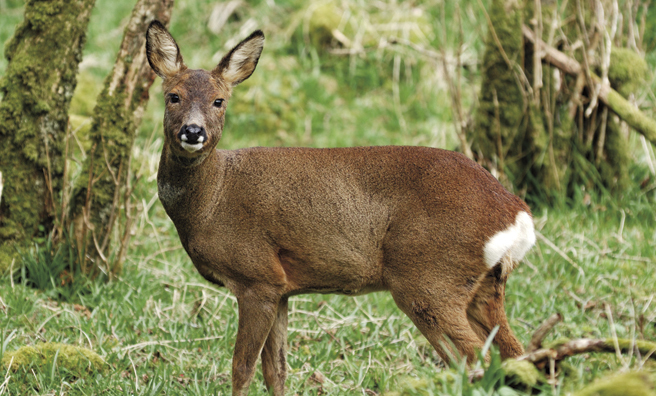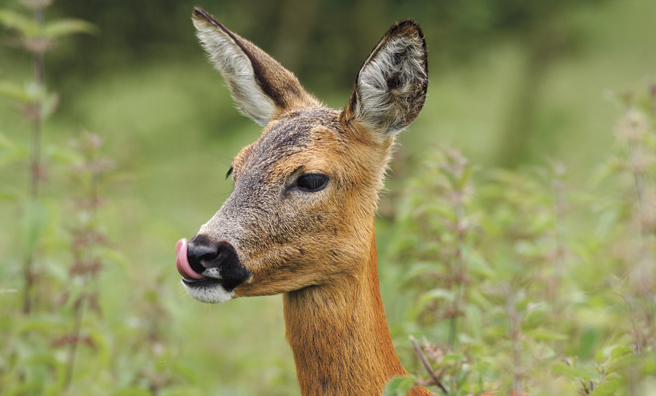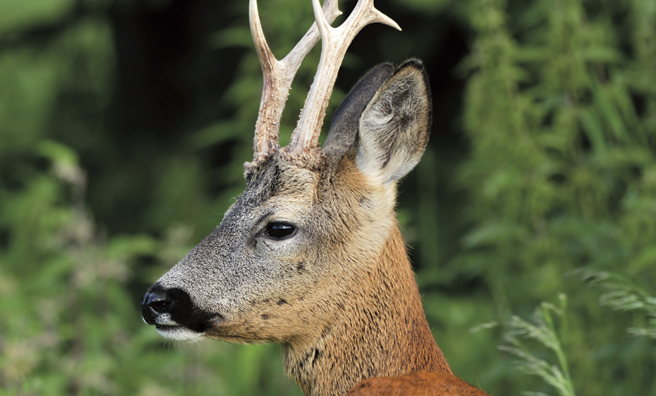Meeting Mother Nature

The roe doe is the spirit of the edge of the wood this bright and mellow May evening. And what on earth, you might well ask, do I mean by that?
Only this: I have been sitting here for I really don’t know how long, but long enough to watch the late afternoon fold away into evening, and in hope of seeing (among other things) the male osprey fly in across the top of the wood with a trout from the loch half a mile away. My perch is high enough to see over the woodland canopy to the distant eyrie’s huge and undignified intrusion onto the summit of a very tall and elegant conifer. But so far, the only glimpse of osprey is the white blur of the sitting female’s head protruding above what looks like a crannog of sticks.
The roe doe has been in and out of the edge of the trees half a dozen times
On the other hand, the roe doe has been in and out of the edge of the trees half a dozen times, nibbling away the hours in the new growth of ankle-high grass between the trees and the bank of the burn that flows dead straight for half-a-mile along the north side of the wood.
As the sun lowers and the beams that slant down through the trees turn a deeper yellow, she steps nimbly on her shadow from trees to open grass to the burn, wading there knee-deep to drink in a pool of warm light and pausing in the drinking to stare at a patch of fresh green bracken and to utter a single muted bark.
Twice now she has disappeared into the trees for about twenty minutes at a time, but reappeared each time exactly where she had entered the trees.
Does she have a fawn hiding in a woodland clearing? Or does she have a fawn in the bracken patch?
That thread of her meandering is the spirit of the evening
So it seems to me that she weaves the thread of her presence among all the elements of the evening – the wood, the grassland, the bracken, the burn, the pools of sunlight, the tree shadows that angle away from the woodland edge towards the burn, and that thread of her meandering is the spirit of the evening. That’s what I meant.
Her presence in and her absence from my sight have consumed my watch, her absence because when she is absent she has merely removed her presence into the trees and there she is watched by other eyes, by woodland eyes like her own, while my own eyes explore the woodland edge and wonder what she is doing.
All this I have watched from an earthy shelf just below the top of a high, brackeny bank on the far side of the burn from the wood – just below the top so that my shape is under the skyline. I have used the shelf many times before, over many osprey seasons, and roe deer have always figured in the watching. Otherwise, I have made no attempt at concealment but trust to stillness and the constancy of a light breeze.
Her fawn, if she has one, also trusts to stillness. For that matter, it is commanded to stillness by the reassuring bark of her mother.
She barks again, but softly
She wades across. Now she is on my side of the burn, perhaps eighty feet below me. The next few steps she takes are in grass but then she is in among the young bracken, new fronds unfurling their greenery all across the old tea-coloured bed of last year’s dead and flattened stems. She barks again, but softly, advances a few yards, lowers her muzzle, but just when I expect to see her fawn rise from hiding on skinny anglepoise legs, she stops, looks round, looks puzzled. Then she turns back towards the burn, and because she is no longer thirsty she jumps rather than wades across.
She jumps from a standing start and in one spring-heeled arching leap. A moment is burned into my mind: she is in the air and her body tilts upwards towards the sun, her hind legs straight out behind her, her forelegs tucked up beneath her before they thrust forward to reach for dry land. She is spotlit by the sun, the rump is a vivid blaze of bright white, her coat is prime summer red.
Then she reaches out, touches down – a dozen yards from a standing start. Try it some time and see how far you get.
What was in the bracken that troubled her? No fawn rose to meet her. I marked the spot carefully. I am tempted to go down for a look. Against that idea is the argument that I have already established my presence in this small glen a mile or two south of the Highland Edge without being observed. I am well placed to see her whenever she returns, and for that matter to see the osprey if he ever returns. If I go down to search in the bracken I would be out of sight of the homing osprey, I would put my scent where the doe would find it, and if she happens to reappear while I’m down there I would alarm her to the extent that I wouldn’t see her again for hours.
I remind myself – let nature come to you
So I remind myself of my first commandment – let nature come to you. You know that’s how it always works best. You’ve done the hard work getting in here. Now stay where you are. You can check the bracken when you’re leaving.
But half an hour drifts by and there has been no osprey, no roe doe, no fawn, in fact no sign of anything at all. It is as if a spell has been broken by the roe’s apparently troubled about-turn. Maybe she picked up my scent then, maybe there was some brief fickle variation in the breeze that I missed but she, being a roe deer, did not.
My attention starts to wander. I have reached that point when I have stopped being useful to myself. It happens after a few hours; the quality of the watching falters.
I decide to call it a day. I will go straight down the bank to where I thought there was a roe fawn and have a quick inspection of the bracken, then walk out quietly in deep shadow.
Inches from her back legs are two very new fawns
Halfway down the bank and she is there, spotlit in the edge of the wood, and behind her, inches from her back legs, are two very new fawns. She and I freeze in the same instant. She stares for perhaps ten seconds. Then she raps out a throaty bark and turns and becomes shadow, becomes woodland. She did not run away or bound away, she became shadow and eased herself and her fawns back into their sanctuary. I wait for a few minutes then go on down to the bracken where she had stopped and turned.
There is a flattened patch in the bracken and traces of blood and afterbirth. For some reason, with her fawns safe in hiding in the wood, she returned to the place where she had given birth. I have never heard of that before. What I would love to have seen was how she got the fawns across the burn.
Roe deer twins are not unusual if the habitat and the feeding are good. That little glen with its burn, its grass, its bracken bank and the proximity of the wood is just about perfect. Somewhere nearby there will be a solitary tree with a circular track round it, a track of flattened grass made by buck and doe during the rituals of mating, probably last July, and quite possibly a traditional site used by many generations of deer.
By then, too, the glen will have become a bit oppressive for the human watcher, the bracken chest-high, and the combined efforts of midges and flies mitigate against the kind of watch I have just enjoyed. I’ll look for the tree in the winter, perhaps, when the track will be easier to see. By then, the deer will wear their winter coats of hodden greyish-brown with a white “scarf” at their necks.
I have come across roe deer high on the heathery hillsides of the Pentlands far from any kind of cover at all. Deep in the pinewoods of the Cairngorms, they move effortlessly from the Black Wood of Rannoch far out onto Rannoch Moor. When I lived in Balquhidder I used to see them daily. Right now, they seem to be prospering in much the same way that buzzards are prospering, which means they are also no stranger to the parks and suburbs of towns and cities. But this is how I like to meet them best, along a quiet woodland edge towing twin fawns in and out of tree shadows and the lowering sunlight of a May, evening drenched in warbler and thrush song – and there, suddenly, at last, the thin ascending falsetto voice of the brooding osprey on the eyrie as her mate flies in over the trees with a beheaded trout in his talons.
The doe lifts her head to the sound, the spirit of the woodland edge acknowledging the spirit of the sky.
- A roe deer on the Island of Islay (Pic: Laurie Campbell)
- A female roe deer (Pic: Laurie Campbell)
- A majestic roe buck with summer coat (Pic: Laurie Campbell)
- Mother and fawn keeping a watchful eye
Roe deer facts
- Roe deer do not live in herds – they are often seen on their own or as a mother and offspring family group
- They are most active at dusk and dawn
- Their antlers have no more than 3 points
- Lifespan is about 7 years in the wild but they can live to 16 years








